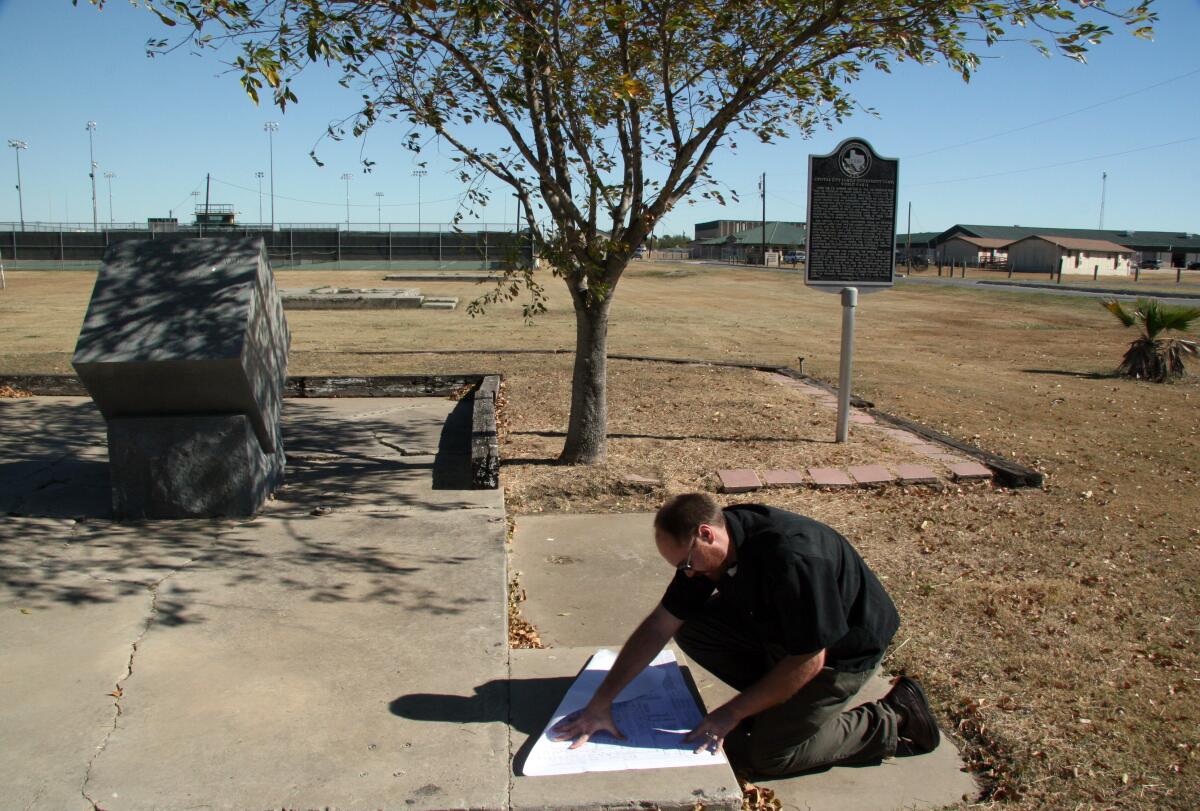Japanese from Latin America, forced into U.S. wartime incarceration camps, fight for full reparations

- Share via
At age 7, Libby Yamamoto came home from a sleepover to find that her father had been taken away by the village police in their Peruvian town.
For the record:
11:21 a.m. Feb. 22, 2022An earlier version of this article said that more than 120,000 Americans of Japanese ancestry were forced into concentration camps. The number includes Japanese Americans and citizens of Japan residing in the U.S.
It was 1943, and as World War II raged, mounting numbers of Japanese in her country were also rounded up by authorities.
The U.S. government had ordered the operation, citing “hemispheric security,” according to historians and accounts from survivors.
The previous year, President Franklin Roosevelt had authorized the relocation of people deemed to pose a threat to national security, resulting in the mass incarceration of more than 120,000 people of Japanese ancestry.
Now, the government effort to lock up Japanese people was extending beyond U.S. borders.
More than 2,200 Japanese from countries including Peru and Bolivia were shipped to the U.S. and confined in concentration camps.
Some were swapped for U.S. citizens in a prisoner exchange with Japan, according to a lawsuit filed by the ACLU seeking reparations.
“We didn’t know when my dad would be back — or if he was even coming back,” recalled Yamamoto, now 86 and living in Richmond. “They showed up so quick, having no explanation.”
In 1998, the ACLU lawsuit resulted in a settlement with the U.S. government granting each survivor from Latin America $5,000 — a fourth of the $20,000 that incarcerated U.S. citizens received in reparations.
Most took the money, feeling it was the best they could get.
Others thought the smaller amount was insulting and turned it down, pointing to the double injustice of being brought to the U.S. against their will, then getting less compensation because they weren’t American citizens.
With the 80th anniversary of Roosevelt’s Executive Order 9066 on Saturday, advocates are seeking full reparations for the internees from Latin America, many of whom have died or are of advanced age.
Next Thursday, advocates plan to flood the White House with phone calls as part of the Campaign for Justice: Redress NOW for Japanese Latin Americans.
Grace Shimizu of Oakland, whose father and other relatives were transported from Peru and incarcerated in the U.S., is director of the Japanese Peruvian Oral History Project and the Campaign for Justice.
The anniversary, as well as the recent racial reckonings and rise in anti-Asian hate, make this the right time for another push for reparations, she said.
“Imagine the grief, the terror of being taken away from your country, stripped of your rights, landing in the U.S. and not speaking English and not given choices,” Shimizu said. “We think 80 years is enough. We shouldn’t have to wait longer for proper justice.”
Phil Tajitsu Nash, lecturer and co-founder of the Asian American Studies Program at the University of Maryland, said many young people have never heard about this “horrible” chapter of World War II history.
“We’re doing this to vaccinate a new generation against the deadly virus that is racism,” he said. “It’s a virus that’s been around before COVID and will stay after COVID — and the timing’s optimum,” said Nash, also a co-president of the Asian American Legal Defense and Education Fund.
In Peru and other Latin American countries, Japanese immigrants were farmers and businesspeople.
On their way to the U.S. concentration camps, some were forced to cut brush with machetes in blistering heat at a way station in Panama.
After their years in the camps, many were deported to Japan. Children born to them while incarcerated were U.S. citizens and received the full $20,000, despite being too young to remember the experience.
Rose Akiko Nishimura’s family had a business importing textiles and manufacturing dress shirts in Lima, Peru.
As a girl, she was forced onto a U.S. Army ship and sent to a concentration camp in Crystal City, Texas.
After she and her family were released, they wanted to return to Peru, but the government would not accept them, so they remained in the U.S.
Tensions erupted among Nishimura and her siblings over whether to take the $5,000 settlement. She and her sisters accepted it, while her brothers did not.
“I don’t understand why we are receiving less than the Japanese Americans. We suffered equally as they did,” Nishimura said in a court declaration in 1999. “Indeed, when you think about it, perhaps even more because we were snatched from our own country and brought to a strange land whose language we did not know.”
Yamamoto, the Richmond resident, spent her early childhood in a Peruvian village called Hacienda Tuman. Her father, Usaburo Maoki, owned a general store there and a tire repair shop in the neighboring city of Chiclayo.
After Maoki was taken away, he was transported to Panama along with his younger brother, where they dug ditches and cleaned toilets, Yamamoto said.
The brothers were first held at Camp Kennedy in Texas before moving to the Crystal City camp. Maoki’s wife and children were also forcibly removed from Peru and eventually joined him at Crystal City, where they lived until May 1947.
At war’s end, “they told us, ‘All you people from Peru, go back to Peru or Japan. You can’t stay here. You’re illegal aliens,’” Yamamoto recalled. “But Peru wouldn’t take us. Besides, my father had lost everything. We had nothing to return to.”
An aunt and a niece helped with their finances and found housing for them in Berkeley. They stayed in the U.S.
Maoki counseled his daughter not to live her years in anger.
“He said that in wartime, even the most logical country can do the most illogical, atrocious thing. We have to move on to forgive,” Yamamoto said.
“Yet victims who were kidnapped still deserve recognition. If nothing else, the government should make amends.”
More to Read
Sign up for Essential California
The most important California stories and recommendations in your inbox every morning.
You may occasionally receive promotional content from the Los Angeles Times.











